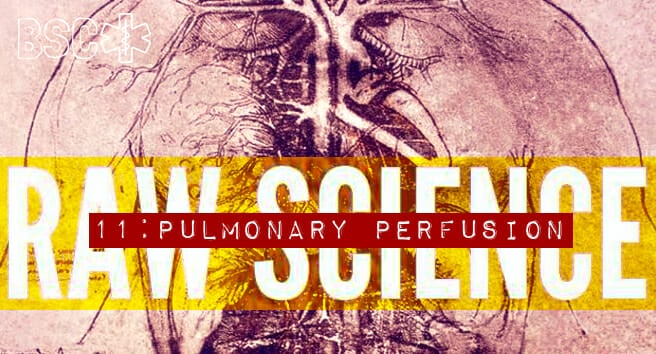Raw Science 11
Pulmonary Perfusion
by Steve Morgan & Sophie Connolly
“The physiology of today is the medicine of tomorrow.” Ernest H. Starling, Physiologist (1926)
Welcome back to the Basic Science Clinic podcast on ICN. Post-hiatus we are ready to reinvigorate the examination of oxygen cascade physiology, from the prevailing atmosphere down to the only organelle that boasts its own bespoke genome, the mitochondrion. In the last podcast we decomposed the minutiae of passive respiratory gas diffusion across the alveolar capillary membrane. Prior to expounding the pre-eminence of V/Q ratios in determining gas exchange sufficiency, we need to publically vivisect the pulmonary circulation to bring you the belated Raw Science 11, Pulmonary Perfusion.
This detailed inspection of pulmonary perfusion is the longest podcast yet, no doubt we got slightly carried away, and thus we have broken it up into three more comfortably digested sections.
Section 1 will include the historical bit and both adult and fetal anatomy. Section 2 examines pulmonary haemodynamics and the integrated control of pulmonary vascular tone. Section 3 details the protean functions of the pulmonary endothelium and endothelial glycocalyx, the determinants of transvascular fluid flux in the lung, all with reference to the pathophysiology of acute lung injury.
The pulmonary circulation participates in gas exchange, blood filtration, metabolic regulation of endogenous vasoactive mediators, drug uptake, metabolism and excretion and the regulation of lung interstitial fluid homeostasis, a dexterous function devastated by the clinical syndrome of ARDS. Understanding the idiosyncracies of the pulmonary circuit is imperative for interpreting heart-lung interactions that influence V/Q distribution & gas exchange efficiency as well as overall cardiovascular performance, particularly during positive pressure ventilation in the context of concomitant shock states.
Factoids
In the average human the pulmonary circulation accommodates nearly 8000L of flowing blood per day, and even with a 500% increase in cardiac output during intense exercise, the pulmonary artery pressure will only undergo a 2-fold increase.
Nearly 90% of the inflated lung volume is air. The remaining 10% of lung volume is comprised of half lung tissue and half blood.
There is 70m2 of pulmonary capillary surface area with only 10m2 for the combined surface area of intra-pulmonary arterioles & venules.
Thank you to everyone for your feedback, we really appreciate it, whether deconstructive or affirmative. It helps us to improve what we are putting out there, and inspires us to keep at it. Get in touch with us via our twitter handles @Falconzao or @sophmconnolly, or message via ICN. We have a new e-mail address, , so send us your suggestions and corrections. Over the coming weeks we will be adding more key concept videos to our website basicscienceclinic.com, so look out for those.
Thanks for listening. Next up we will audit the physiological mechanisms of gas exchange, with a focus on ventilation-perfusion ratios. Until then.

























